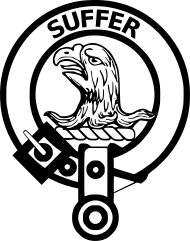Clan Haldane
| Clan Haldane | |||
|---|---|---|---|
 | |||
| Motto | Suffer[1] | ||
| Chief | |||
 | |||
| Martin Haldane of Gleneagles | |||
| 26th Baron of Gleneagles, Chief of the Name and Arms of Haldane | |||
| Seat | Gleneagles House | ||
| Historic seat | Gleneagles House & Airthrey Castle | ||
| |||
Clan Haldaneis a LowlandScottish clan.[1]
History
[edit]Origins of the clan
[edit]Bernard, son of Brien, received fromWilliam the Lionthe manor of Hauden between 1165 and 1171.[1]A cadet of the house is believed to have settled inStrathearnand acquired lands which later became part of the barony ofGleneagles,where the chiefs of Clan Haldane still reside today.[1]The name Gleneagles has nothing to do with the chief's heraldry but is derived from theScottish Gaelic,glenandeaglais,which meansa church.[1]
Wars of Scottish Independence
[edit]In 1296 Aylmer Haldane appears in theRagman Rollsswearing fealty toEdward I of England.[1]However he soon allied himself withRobert the Brucein the struggle for Scottish independence.[1]In 1312 Sir Simon Haldane received a charter for part of the lands of Bardrill in Streathearn from Sir John de Logy.[1]Sir Simon married Matilda de Arnot and in doing so obtained extensive lands within theearldom of Lennox.[1]
15th century
[edit]Sir John Haldane, third of Gleneagles was Lord Justice General of Scotland beyond the Forth, sheriff principal of Edinburgh and Master of the Household underJames III of Scotland.[1]In 1482 he resigned his lands inFife,StirlingshireandPerthshireto the Crown, and as a result received a charter that erected them into the free barony of Gleneagles.[1]He was married to a daughter of Murdoch Menteith of Rusky, through whom he claimed the earldom of Lennox.[1]He began a lengthy lawsuit which resulted inStuart, Lord Darnleyretaining the earldom but Gleneagles was compensated with one quarter of the lands.[1]
16th century and clan conflicts
[edit]In 1505, Sir James Haldane, fourth of Gleneagles was appointed Governor ofDunbar Castle.[1]His son, Sir John Haldane, fifth of Gleneagles was responsible for erecting lands inLennoxandPerthshirethat were not already part of Gleneagles into the barony of Haldane.[1]The seat was then at Rusky House.[1]He was killed at theBattle of Floddenin 1513.[1][2]
In 1560 Robert Haldane, laird of Gleneagles, and his brother John, were at theSiege of Leithin support of theScottish Reformation.[3]Embracing the reformation, the Haldanes played a prominent part in the political upheavals that removedMary, Queen of Scots.[1]The Haldanes were part of a force that laid siege toStirling Castlein 1585.[1]They were attempting to persuade the king to rescind the banishment on theEarl of Angusand other unruly Protestant nobles.[1]James Haldane, brother of the Laird of Gleneagles, led an attack on the west port of the castle.[1]He engaged Sir William Stewart, colonel of the Royal Guard and drove him back.[1]However Haldane was shot while on the point of victory by Stewart's servant.[1]
17th century and Civil War
[edit]Sir John Haldane, eleventh Laird of Gleneagles was a professional soldier who fought forHenry, Prince of Orange,along with his brother, James Haldane in the Netherlands.[1]He was knighted byCharles I of Englandin 1633 and represented Perth in Parliament.[1]He was a strong supporter of theNational Covenantand his estates became burdened with debts as a result of raising men and supplies.[1]He is credited with building the present House of Gleneagles and fought for the royalist army, leading his regiment against Parliament at theBattle of Dunbar (1650).[1]
18th century and Jacobite risings
[edit]GeneralGeorge Haldane,son of the sixteenth Laird was a professional soldier who fought against the French at theBattle of Dettingenin 1743 and theBattle of Fontenoyin 1745.[1]George Haldane also served under theDuke of Cumberlandagainst the Jacobites in the campaign of 1745 - 1746.[1]
19th to 20th Century
[edit]In 1820 the estates passed to a cousin of the eighteenth Haldane of Gleneagles, Admiral Adam Duncan, Viscount Duncan of Camperdown, who was renowned for his victory at theBattle of Camperdownin 1797.[1]The Admiral's son assumed the surname of Haldane and was raised to the title of Earl of Camperdown in 1831.[1]
The fourthEarl of Camperdownresigned his estates to his kinsman, James Chinnery-Haldane in 1918.[1]James's son, Alexander, succeeded as clan chief.[1]Another of his sons, Brodick, was a renowned portrait photographer.[1]Alexander died in 1994 and the chiefship passed to his nephew Martin.[1]
Clan Chief
[edit]The current chief of Clan Haldane is Martin Haldane of Gleneagles, 26th Baron of Gleneagles.[4]
See also
[edit]References
[edit]- ^abcdefghijklmnopqrstuvwxyzaaabacadaeafagahaiajWay, George of Plean;Squire, Romilly of Rubislaw(1994).Collins Scottish Clan & Family Encyclopedia.Glasgow:HarperCollins(for theStanding Council of Scottish Chiefs). pp. 158–159.ISBN0-00-470547-5.
- ^Guthrie, William(1767).A General History of Scotland.Vol. 4.Paternoster Row,London: A. Hamilton, Robinson and Roberts. pp.371-372.Retrieved7 May2023.
- ^Protocol Book of Gilbert Grote,SRS (1914), p.42 no.191
- ^"Burke's Peerage".Burke's Peerage.1 August 2024.Retrieved1 August2024.
